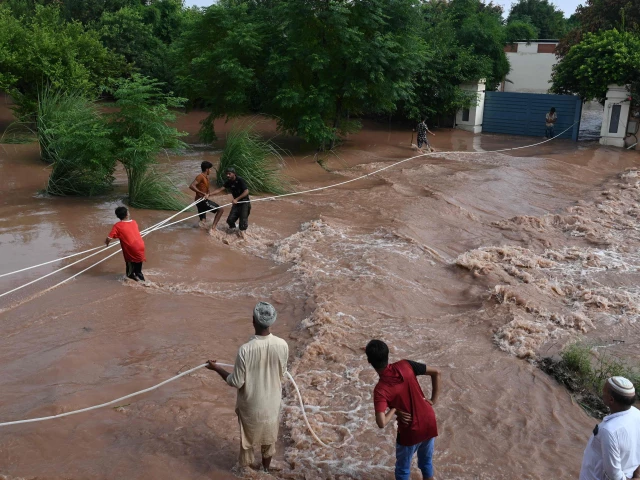A new model uses AI predictions to trigger money transfers before overflow, helping families evacuate and protect their assets.
Citizens pass through the flooded area of Narowal, a town in Punjab, on August 27, 2025. Photo: AFP
As this year’s floods have devastated rural areas and displaced countless families, it is more important than ever to have systems in place that can anticipate and preemptively deliver aid to affected populations.
The nonprofit GiveDirectly is testing a new approach to combating flooding: sending money to households before water levels rise. Advance Cash Assistance uses AI to predict areas where flooding will occur and disburses payments when certain risk thresholds are reached.
GiveDirectly said it transferred US$105 to thousands of households in Nigeria within 48 to 72 hours of the predicted flood threshold in June, allowing families to evacuate, fortify their homes and protect livestock ahead of the flood. The group also reported that “incomes have more than doubled, food insecurity has dropped by 90%, and most beneficiaries feel better prepared for future floods.”
Read: Record floods displace millions in Punjab
The model relies on Google’s Flood Hub, a forecasting platform that now covers more than 80 countries and offers up to seven days of flood forecasts. By leveraging Google’s AI systems, humanitarian agencies and governments can use it to receive alerts at the village level, and Pakistan is among the countries covered.
Humanitarian agencies argue that paying early is both more dignified and cost-effective than traditional aid that arrives after losses mount, and similar ideas have been tested in Bangladesh and other regions, with studies suggesting that anticipatory action can shorten recovery time and reduce humanitarian costs.
How Pakistan can implement a similar system
Pakistan has real-time river data through the Pakistan Meteorological Department’s Flood Forecasting Division (PMD/FFD) and can use the Google Flood Hub (and its AI systems) to monitor parameters such as predicted river flow levels, flood probabilities, etc.
By identifying and registering vulnerable households, such as through the Benazir Income Support Program (BISP), the government can set up digital wallets to get funds to people as quickly as possible. BISP has already partnered with JazzCash for disbursement of funds, which can therefore be tailored for flood relief.
Additionally, by connecting forecasts from PMDFFD flood centers with satellites from the Space Applications Center for Emergency and Disaster Response (SACRED) of the Pakistan Space and Upper Atmosphere Research Commission (SUPARCO), we can refine the data for high accuracy and ensure precise targeting of at-risk settlements.
By integrating “anticipatory action” into the National Disaster Management Authority’s proactive monsoon guidelines and using the National Disaster Risk Reduction Strategy to For the period 2025-2030, we can both plan for floods and take care of our populations before floods, by clarifying how those at risk receive compensation and the conditions for obtaining this compensation. There may also be a verification system to control errors and fraud built into the policy framework.
However, special consideration will need to be given to people living in areas that do not receive consistent mobile phone signals or those who are not digitally connected.
Testing a system in the lower Indus of Sindh and southern Punjab, where flood risks are high, with the help of an independent partner, would be a good first step towards a system capable of saving and supporting many people.




